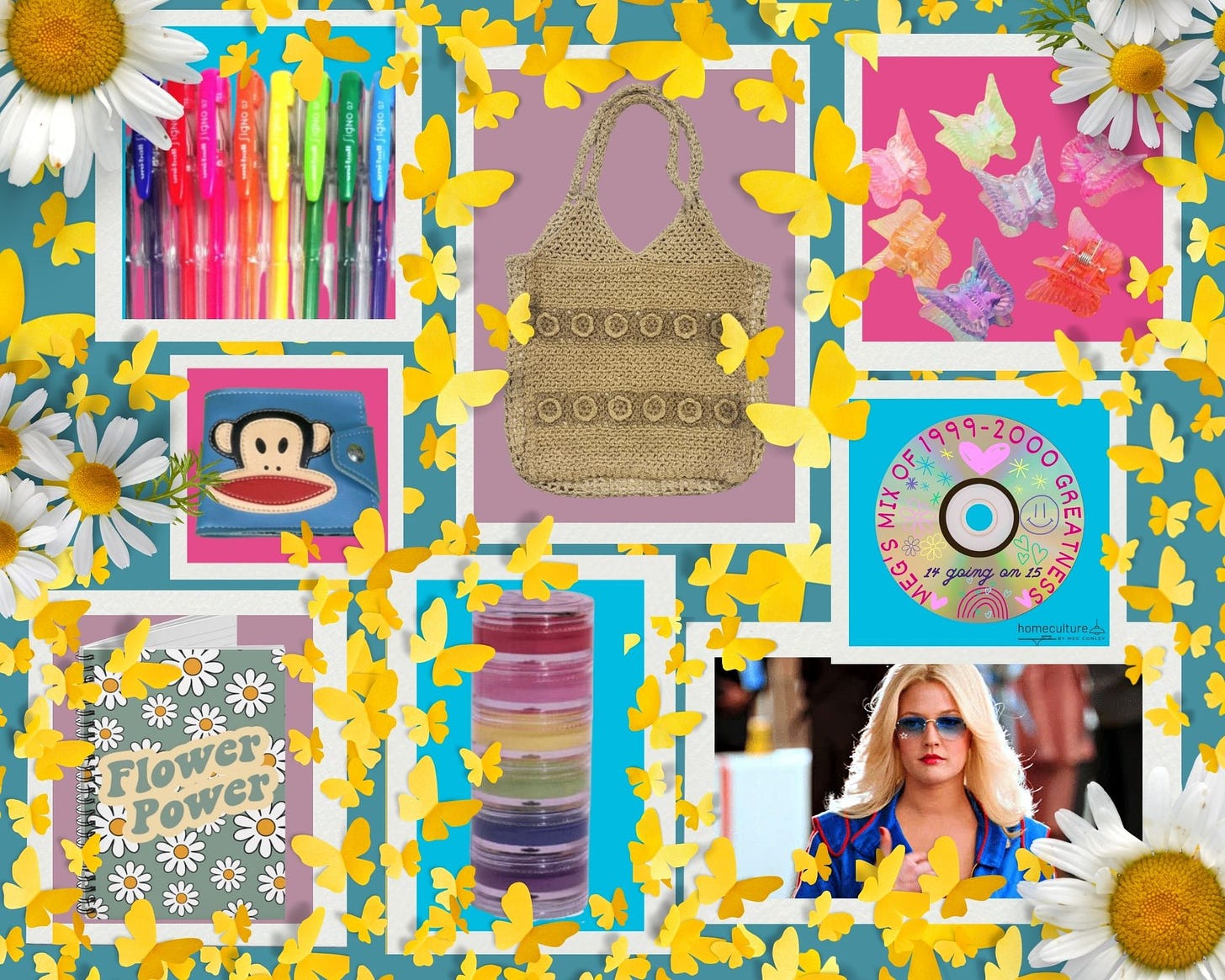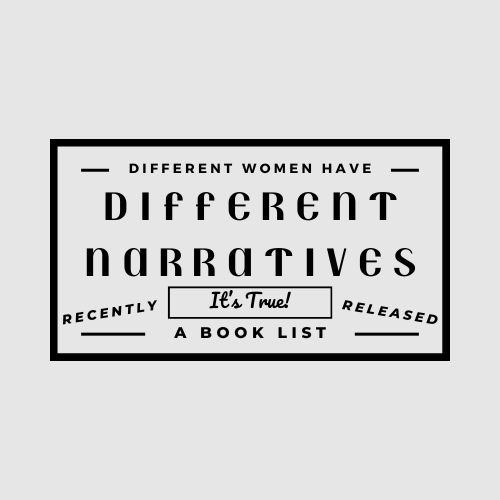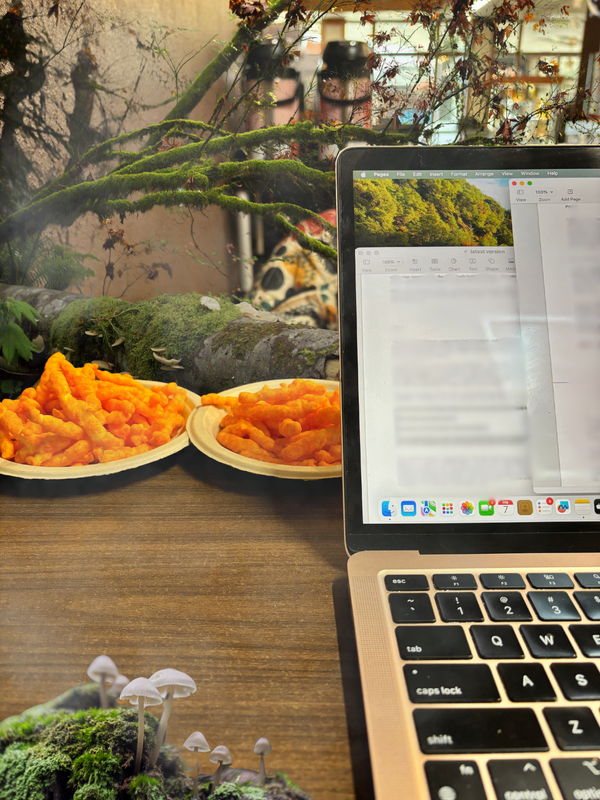This piece took 1080 minutes to research, write, edit and design.
Here’s how I spent those minutes: I read five academic journal articles. (One of which was so hateful I had to talk a walk afterward. Don’t worry, you’ll know what I am talking about half way through the essay.) I spent three hours learning about an anti-Katie Porter congressional candidate ALL FOR FOOTNOTE NUMBER FIVE.(Please read FOOTNOTE NUMBER FIVE!) I learned the entire history of purses. PHEW. I wrote and edited the piece.
I also figured out how to use Canva so that I could make a proper exhibit for my 14 year old purse and a cover for the burned CD playlist I include at the end of the piece. The mixtape took an addition 45 minutes to compile.
If you enjoy my work, consider becoming a paid supporter. When you sign up for a paid subscription, you’re giving me 12 minutes a month to write. I promise not to waste a second. (Plus there’s lots of fun member-only perks!)

I asked for a purse for my fourth birthday. I wanted one that I could drape from my wrist when I walked with my mom as she pushed my sister’s stroller. I thought purses were for holding treasures. The treasures I had. A rock that almost looked like a crystal. A little lucite charm I found in my grandma’s jewelry box. An old coin my grandpa gave me on my last visit to New Mexico. A Rainbow Brite pencil.

The treasures I’d find on walks and errands. The rare leaf turned red and yellow in my California fall, I could just reach down and pick it up. A bakery’s business card with a picture of a cupcake, I could just reach up and take one. I got the purse for my birthday. I don’t remember what it looked like. I can remember the weight of it.
On Monday, a story about a lost purse went viral. Fourteen year old Beverly Williams left her purse at her Texas high school in 1959. The purse was found this year, as the school was being torn down. Local historians used the items in the purse to identify its owner. Williams died years ago. Her daughter cried when she heard about the discovery. In the photos accompanying the article, the contents of Williams purse are laid out carefully in a full exhibition. The lives of girls deserve to be taken seriously. It’s a lovely story.
What is it about a girl’s purse that draws so many eyes?
But there was also something about the internet’s reponse that left me a little restless. Would a boy’s backpack from 1959 gotten as many retweets and press mentions? What is it about a girl’s purse that draws so many eyes?
What was in the purse?
— Houston Chronicle (@HoustonChron) October 8, 2022
Exactly what you’d expect of a young teenager: a diary, a comb, a nail file set and even photos of her father, sisters and male crushes.https://t.co/eHosFz2Vzq pic.twitter.com/KrpHK0g50r
Purses are relatively new accessories. Women used to carry their necessities in pockets tied around their waist, worn under their layered skirts. The pockets were a kind of undergarment, hidden by the thickness of a woman’s outer layers. But when skirts slimmed, the bulk of the under-pockets poked through the skirt fabric. A curator for the Women’s Museum of California wrote that, “Pocket-lines were the panty-lines of the 1790s.”
The purse was the solution for the unsightly revelation. Women began carrying little purses called reticules. Some people were scandalized, as the little purses still looked like pockets. They thought women were walking around with underwear draped from their wrists.1 A purse was not a purse, it was an outline of women’s most secret places.
I asked for a purse again when I turned twelve. I wanted one that I could clutch at my side when I walked out the door of my house in the suburbs. I thought purses were for holding embarrassing things. The embarrassing things I needed all the time. A brush, because my hair never laid flat. Mascara, because I was always rubbing my eyes and smearing my makeup. Gum, one time a boy in my math class said I had bad breath. I’d had a tuna sandwich for lunch. I stopped eating tuna, but chewed gum constantly.
A purse was not a purse, it was an outline of women’s most secret places.
The embarrassing things I only realized I needed in a moment of panic. A pad wrapped in pink plastic, I’d fumble it open in a public bathroom as I prayed I hadn’t bled through my shorts again. A tiny stick of deodorant, I couldn’t seem to stop sweating even when I was sitting still. I got the purse for Christmas. I can’t remember what it looked like. I remember how hot my face felt when I’d dig through it looking for another embarrassing thing.
Our culture’s obsession with the purse and female sexuality carried into the 20th century. Surprising absolutely no one, Freud insisted a woman’s purse “was a substitute for her genitals”2 and that a woman rifling through her purse was “representative of masturbation.” In my experience, masturbation is nothing like trying to find a pen in the deep recesses of a purse. But it is not surprising at all that Freud viewed female pleasure as a frustrated search. Ahem.
In 1997, the year I turned twelve, Sontag favorite Salmagundi published The Content of Women’s Purses: An Accessory in Crisis by Daniel Harris. The essay is so ripe with misogyny, I spent an hour3 trying to figure out if it was joke. It appears to be in earnest. Even if I’d found a punchline, it’s the kind of joke that’d only get a laugh from misanthropes.
Daniel Harris argued the purse is a relic of the pre-industrialized repressed woman. His repressed woman lived in domestic sphere rife with frigid possessiveness.4Harris thought women carry purses so they can keep clutching that dark aged domestic sphere while standing blinking and confused in the sun of the public sphere. For Freud, the purse was a woman’s genitals. For Harris, it is her blighted womb. He called the purse,
“an almost tragic collection of the good intentions of the efficient homemaker who, while she dreams of mending and recycling the avalanche of clutter she carries, simply does not have the time, ingenuity, or will power to carry out the aborted projects and stillborn ideas contained in a bag that, however stylish, frequently amounts to little more than a traveling lost-and-found.”
Harris hated purses! He hated women who carry them! So much! He went on,
“the proverbial rat’s nest of the purse, which sometimes looks like the lair of a slovenly nocturnal creature, is also the result of a strong psychological need for mess, which women use as a form of rebellion.”
I just want to know how many times he’s asked a friend if she’ll carry his keys in her purse.
He declared the homemaker of the past “over-dressed, uptight, priggish”, a “dowdy matriarch in her support hose and sensible shoes, clutching her pocketbook like an anxious hen.” As for the woman in the workplace, he was really disgusted by her, too. He argued that
“the pocketbook is the place on her own body where the perfectly manicured office worker makes a kind of mud pie, indulging in an infantile act of liberating self-desecration.”
By the end of the essay, Harris concluded women will only sexually liberated once they’ve abandoned purses. I don’t know where the sexually liberated purseless women were supposed to keep the condoms purseless men refuse to carry.
Harris also predicted purses were on their way out as an accessory. Which is interesting in the context of the purse as a blighted womb. Many women have uteruses and bleed every month. They carry menstruation products in their purses to address those bloody days. If we toss out wombs I mean purses, I mean wombs, I guess those women will have less to carry.
I saved up for a new purse when I was fourteen. I wanted one that I could drape across my left shoulder when I walked with my best friend around the mall. I thought purses were for holding treasures. The treasures I had. Rainbow colored gel pens, with ink that slid across paper like frosting. A notebook, for the things I thought but couldn’t say. A stack of rainbow colored lip glosses, even though I only used the pink and red. The blue Paul Frank wallet my mom got me for Christmas. A rotating CD of songs burned for a friend, or by a friend. A few butterfly clips, my hair still didn’t lay flat. Knock off Charlie’s Angels glasses, I felt like Drew Barrymore when I put them on.

And the treasures I’d find. A note Riley passed me in our LDS church meetinghouse, I could just reach over and take it. A trilobite fossil I found in a creek on a trip to Kentucky, I could just reach down and grab it. I remember what that purse looked like, a straw tote with little straw flowers strung across it.
In 2011, Quentin L. Cook, an Apostle in the LDS Church, gave a talk praising LDS women for their unpaid care work. In the talk, he told a story the LDS Church calls The Parable of The Purse. Cook’s version of the purse is about female sexuality too - the purse is proof of female purity. In the “parable”, a teenage girl left her purse at a church dance. Her youth group leaders unpacked the purse to try to identify the girl. With each item retrieved from the purse, the leaders assigned the girl a virtue. In Cook’s sermon, the contents of the girl’s purse were put on exhibition as a “a quiet example of a young lady living the gospel.”
Homemaking is the pinnacle of the story because it’s the pinnacle of Cook’s concept of womanhood.
The purse held a pamphlet of church youth standards, with instructions about chastity and modesty. There was also a notebook with scriptures written inside of it. Both were evidence the owner is a “stalwart young woman.” Next they pulled out, “breath mints, soap, lotion and a brush.” She could have had the breath mints because she planned on making out with someone in the parking lot of the church dance. But that’s not how Cook or her leaders interpreted them. Cook said he loved what the leaders said upon finding the toiletries, “Oh, good things come out of her mouth; she has clean and soft hands; and she takes care of herself.”
A homemade coin purse and cash followed, each proving the purse owner was “creative and prepared.” And finally, a recipe for a cake with a note that she was going to make it for a friend. When they found the recipe, Cook said the leaders “almost screamed, 'She’s a HOMEMAKER! Thoughtful and service minded.'”Homemaking is the pinnacle of the story because it’s the pinnacle of Cook’s concept of womanhood.5
There is no Parable of the Pocket. Men are never reduced to what they carry.
The Parable of the Purse has been told over and over to young LDS girls. Many have been invited to Parable of the Purse activities with construction paper purse crafts and purse shaped tea sandwiches. Their leaders work hard on those crafts and sandwiches. They’ve also been told, in and out of church, that a purse is never just a purse. Is it any surprise that they teach what they’ve been taught? Of course, there is no Parable of the Pocket. Men are never reduced to what they carry.
I bought myself a purse this year. I am 37. I wanted one I could pull over my head and across my chest when I walk around my city neighborhood. I think purses are for holding whatever needs carrying. The things I carry now. A wallet, the width of the Strawberry Shortcake sugar skull sticker I stuck on it months ago. My phone, in a case chewed up by our puppy. A receipt my dad signed, the year before he died. The things I’ll need to carry. A crumpled wrapper from the snack Brontë eats on her way into ballet, I’ll reach out and take it. One of the millions of leaves turned red and yellow in my Denver fall, I can just reach down and pick it up. I could tell you what the purse looks like, but I don’t think I will.
But I will give you a playlist of all the songs I would’ve burned onto a CD during my 14th and 15th years. Please ironically enjoy Meg’s Mid-teen Musical Taste.
1 The Hand Bag, An Illustrated History, Caroline Cox, Harper Design, 2007
2 Hiner, Susan. Accessories to Modernity: Fashion and the Feminine in Nineteenth-Century France. University of Pennsylvania Press, 2010.
3 60 minutes
4 HARRIS, DANIEL. “The Contents of Women’s Purses: An Accessory in Crisis.” Salmagundi, no. 114/115 (1997): 122–31. http://www.jstor.org/stable/40548965.
5 The story feels fake because the leader’s responses sound scripted. But Cook shared the name of the leader in his talk. I looked her up. She’s real. So is her husband, Don Sedgwick. In 2019, he was the Mayor of Laguna Hills, California. In 2020, he ran in the Republican primary for a congressional seat in California’s 45th congressional district. He promised to unseat Katie Porter and help make Trump’s wall a reality. He did neither. During the primary, he mentioned several times that he helped run a yearly symposium on the family. He neglected to mention the symposium is put on by the Church of Jesus Christ of Latter-day Saints.
While he nodded at the moral value of unpaid care work, Sedgwick received a large donation from CareTrust REIT. CareTrust is a real estate investment company that deals exclusively in senior housing. 78% of the CareTrust portfolio is skilled nursing homes. There is a grim consistency in promoting the traditional extraction of unpaid care work from the American Home™ while taking money from people who extract profits from underpaid care work and the elderly who need their care.
Image sources: Butterfly Clips Flower Notebook Purse








